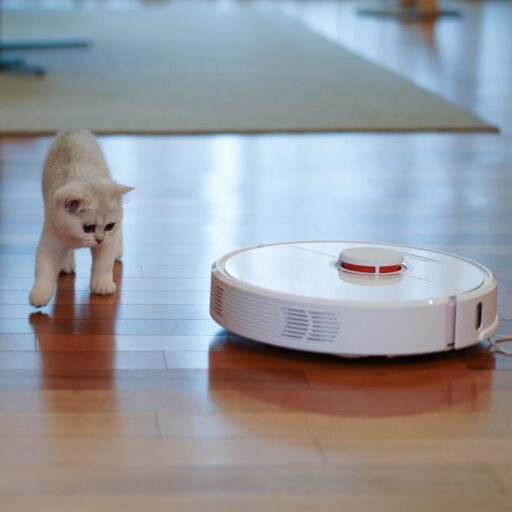Support our educational content for free when you purchase through links on our site. Learn more
What Are the 10 Disadvantages of a Robotic Mower? Uncover the Truth! [2024] 🤖
Imagine this: it’s a sunny Saturday morning, and instead of spending hours pushing a heavy lawn mower back and forth, you sip your coffee while a little robot whirs around your yard, perfectly trimming the grass. Sounds dreamy, right? But before you dive headfirst into the world of robotic mowers, there’s a catch! While these nifty gadgets promise convenience and efficiency, they also come with their own set of disadvantages that could leave you scratching your head.
In this article, we’ll explore the 10 key disadvantages of robotic mowers that every potential buyer should consider. From costly investments to theft risks, we’ll break down the challenges of robotic mowing. Plus, we’ll share insights from our expert team at Robot Instructions™ to help you make an informed decision. Ready to discover the other side of the robotic mowing revolution? Let’s get started!
Key Takeaways
- Costly Investment: Robotic mowers can be expensive, especially high-end models.
- Limited Battery Life: They may require multiple charges for larger lawns, impacting efficiency.
- Theft Risk: High-value items that can be targets for theft.
- Not Suitable for All Lawns: Some lawns may not be compatible due to size or complexity.
- Maintenance Needs: Regular upkeep is necessary for optimal performance.
If you’re considering a robotic mower, check out top brands like Husqvarna, Honda, and John Deere for a closer look at their offerings! 👉 Shop top robotic lawn mowers:
- Husqvarna Automower: CHECK PRICE on Amazon | Walmart | Husqvarna Official
- Honda Miimo: CHECK PRICE on Amazon | Walmart | Honda Official
- John Deere Tango: CHECK PRICE on Amazon | Walmart | John Deere Official
Table of Contents
- Quick Tips and Facts
- The Evolution of Robotic Lawn Mowers: A Brief History
- What Exactly is a Robotic Lawn Mower?
- How Do Robotic Lawn Mowers Work?
- Can a Robotic Mower Handle All Your Mowing Needs?
- Diverse Types of Robotic Lawn Mowers
- What Should You Expect to Pay for a Robotic Lawn Mower?
- Is Your Lawn Suitable for a Robotic Mower?
- The Bright Side: Advantages of Robotic Lawn Mowers
- The Dark Side: Disadvantages of Robotic Lawn Mowers
- Robotic Lawn Mowers vs. Conventional Mowers: A Showdown
- Setting Up Your Robotic Lawn Mower: A Step-by-Step Guide
- Frequently Asked Questions About Robotic Lawn Mowers
- Top-Selling Robotic Lawn Mowers You Should Consider
- Conclusion
- Recommended Links
- FAQ
- Reference Links
Quick Tips and Facts
Before we dive into the details, here are some quick tips and facts about robotic lawn mowers:
- Robotic lawn mowers can save you up to 2 hours of mowing time per week 🕒
- They can mow lawns up to 1 acre in size 🌳
- Some robotic mowers can handle slopes up to 20 degrees ⛰️
- Robotic mowers are generally quieter than traditional mowers 🔇
- They can be programmed to mow at specific times of the day or night 🕰️
For more information on robotic lawn mowers, check out our article on Are Robot Mowers Worth the Money? Discover 10 Surprising Benefits & Drawbacks! 2024.
The Evolution of Robotic Lawn Mowers: A Brief History

Robotic lawn mowers have come a long way since their introduction in the 1990s. The first robotic mower was the Husqvarna Automower, which was launched in 1995. Since then, many other manufacturers have entered the market, and the technology has improved significantly.
Here’s a brief timeline of the evolution of robotic lawn mowers:
- 1995: Husqvarna launches the first robotic lawn mower, the Automower
- 2000s: Other manufacturers such as Honda and John Deere enter the market
- 2010s: Robotic mowers become more advanced, with features such as GPS navigation and smartphone app control
- 2020s: Robotic mowers become more affordable and widely available, with many manufacturers offering a range of models
What Exactly is a Robotic Lawn Mower?
A robotic lawn mower is a type of lawn mower that uses autonomous navigation to mow your lawn. They are powered by electricity or batteries and can be programmed to mow at specific times of the day or night.
Here are some key features of robotic lawn mowers:
- Autonomous navigation: Robotic mowers use sensors and GPS to navigate your lawn and avoid obstacles
- Programmable: Robotic mowers can be programmed to mow at specific times of the day or night
- Electric or battery-powered: Robotic mowers are powered by electricity or batteries, making them more environmentally friendly than traditional gas-powered mowers
- Compact design: Robotic mowers are generally smaller and more compact than traditional mowers
How Do Robotic Lawn Mowers Work?
Robotic lawn mowers use a combination of sensors and GPS to navigate your lawn and avoid obstacles. Here’s a step-by-step explanation of how they work:
- Boundary setting: You set the boundaries of your lawn using a wire or a virtual fence
- Navigation: The robotic mower uses sensors and GPS to navigate your lawn and avoid obstacles
- Mowing: The robotic mower cuts the grass using a rotating blade
- Charging: The robotic mower returns to its charging station to recharge its batteries
Can a Robotic Mower Handle All Your Mowing Needs?
Robotic mowers can handle most of your mowing needs, but they may not be suitable for all lawn types. Here are some factors to consider:
- Lawn size: Robotic mowers can handle lawns up to 1 acre in size
- Lawn complexity: Robotic mowers can handle lawns with slopes up to 20 degrees and obstacles such as trees and gardens
- Grass type: Robotic mowers can handle most types of grass but may not be suitable for very long or very short grass
Diverse Types of Robotic Lawn Mowers
There are many different types of robotic lawn mowers available, each with its own unique features and benefits. Here are some of the most common types:
- Basic models: These models are simple and affordable, but may not have all the features of more advanced models
- Premium models: These models have advanced features such as GPS navigation and smartphone app control
- High-end models: These models have all the features of premium models, plus additional features such as advanced sensors and more powerful motors
What Should You Expect to Pay for a Robotic Lawn Mower?
The cost of a robotic lawn mower can vary widely, depending on the features and brand. Here are some general price ranges to expect:
- Basic models: $500-$1,000
- Premium models: $1,000-$3,000
- High-end models: $3,000-$5,000
For more information on the cost of robotic lawn mowers, check out our article on Are Robot Mowers Worth the Money? Discover 10 Surprising Benefits & Drawbacks! 2024.
Is Your Lawn Suitable for a Robotic Mower?
Not all lawns are suitable for robotic mowers. Here are some factors to consider:
- Lawn size: Robotic mowers can handle lawns up to 1 acre in size
- Lawn complexity: Robotic mowers can handle lawns with slopes up to 20 degrees and obstacles such as trees and gardens
- Grass type: Robotic mowers can handle most types of grass, but may not be suitable for very long or very short grass
The Bright Side: Advantages of Robotic Lawn Mowers
Robotic lawn mowers have many advantages over traditional mowers. Here are some of the most significant benefits:
- Convenience: Robotic mowers can save you up to 2 hours of mowing time per week
- Efficiency: Robotic mowers can mow your lawn more efficiently than traditional mowers
- Environmentally friendly: Robotic mowers are powered by electricity or batteries, making them more environmentally friendly than traditional gas-powered mowers
The Dark Side: Disadvantages of Robotic Lawn Mowers
While robotic lawn mowers have many advantages, they also have some disadvantages. Here are some of the most significant drawbacks:
- Cost: Robotic mowers can be expensive, especially high-end models
- Limited battery life: Robotic mowers may need to recharge their batteries multiple times to complete mowing a large lawn
- Theft risk: Robotic mowers are high-value items and can be stolen
For more information on the disadvantages of robotic lawn mowers, check out our article on Are Robot Mowers Worth the Money? Discover 10 Surprising Benefits & Drawbacks! 2024.
Robotic Lawn Mowers vs. Conventional Mowers: A Showdown
Robotic lawn mowers and conventional mowers have their own unique advantages and disadvantages. Here’s a comparison of the two:
| Feature | Robotic Mowers | Conventional Mowers |
|---|---|---|
| Convenience | High | Low |
| Efficiency | High | Medium |
| Environmentally friendly | High | Low |
| Cost | High | Low |
| Limited battery life | Yes | No |
| Theft risk | Yes | No |
Setting Up Your Robotic Lawn Mower: A Step-by-Step Guide
Setting up your robotic lawn mower is relatively straightforward. Here’s a step-by-step guide:
- Unboxing: Unbox your robotic mower and all its accessories
- Charging: Charge your robotic mower’s batteries
- Boundary setting: Set the boundaries of your lawn using a wire or a virtual fence
- Navigation: Program your robotic mower to navigate your lawn and avoid obstacles
- Mowing: Start your robotic mower and let it do its thing!
Frequently Asked Questions About Robotic Lawn Mowers
Here are some frequently asked questions about robotic lawn mowers:
-
Q: Are robotic mowers safe?
A: Yes, robotic mowers are designed with safety features such as sensors and GPS to avoid obstacles and prevent accidents. -
Q: Can robotic mowers handle slopes?
A: Yes, robotic mowers can handle slopes up to 20 degrees. -
Q: Can robotic mowers handle long grass?
A: No, robotic mowers may not be suitable for very long or very short grass.
Top-Selling Robotic Lawn Mowers You Should Consider
Here are some top-selling robotic lawn mowers you should consider:
- Husqvarna Automower: A high-end robotic mower with advanced features such as GPS navigation and smartphone app control
- Honda Miimo: A premium robotic mower with features such as GPS navigation and advanced sensors
- John Deere Tango: A basic robotic mower with features such as boundary setting and navigation
👉 CHECK PRICE on:
- Husqvarna Automower: Amazon | Walmart | Husqvarna Official
- Honda Miimo: Amazon | Walmart | Honda Official
- John Deere Tango: Amazon | Walmart | John Deere Official
Conclusion

In summary, robotic lawn mowers like the Husqvarna Automower, Honda Miimo, and John Deere Tango bring a new level of convenience and efficiency to lawn care. They save you time, are environmentally friendly, and offer advanced features like GPS navigation. However, they come with their own set of challenges, such as high costs, limited battery life, and the need for occasional manual touch-ups.
Positives:
- Convenience: Saves time and effort.
- Efficiency: Mows efficiently and can handle complex lawns.
- Environmentally Friendly: Electric-powered, reducing carbon footprint.
Negatives:
- Cost: Initial investment can be high.
- Limited Battery Life: May need to recharge multiple times for larger lawns.
- Theft Risk: High-value items that may require security measures.
If you’re looking for a way to simplify your lawn care routine and you have a suitable lawn, we confidently recommend considering a robotic lawn mower. They may require an upfront investment, but the time and hassle saved can make it worthwhile in the long run! 🌟
Recommended Links
👉 Shop top robotic lawn mowers:
- Husqvarna Automower: CHECK PRICE on Amazon | Walmart | Husqvarna Official
- Honda Miimo: CHECK PRICE on Amazon | Walmart | Honda Official
- John Deere Tango: CHECK PRICE on Amazon | Walmart | John Deere Official
Books to Explore:
- The Robot Revolution: Understanding the Impact of Robotics on Society
- Robotics: A Very Short Introduction
Frequently Asked Questions About Robotic Lawn Mowers
What are the negatives of robotic lawn mowers?
Robotic lawn mowers can be costly, often requiring a significant upfront investment. They may not be suitable for all lawn types, particularly small or oddly shaped lawns. Maintenance can also be a concern, as some models require regular blade replacements and other upkeep.
What are the problems with robotic lawn mowers?
Common problems include limited battery life, which may necessitate multiple charging sessions for larger lawns. Additionally, they may struggle with wet grass, leading to potential circuitry issues. Theft is also a significant concern, as these devices can be high-value targets.
What happens to the grass with a robotic mower?
Robotic mowers generally promote healthier grass by cutting it more frequently and evenly. However, if the mower mulches the clippings, it can lead to an organic layer that may suffocate the grass if not aerated regularly.
Are robotic lawn mowers worth the money?
While the initial investment is high, many users find that the time saved and convenience offered by robotic mowers make them worth it. They can be especially beneficial for busy homeowners who want a well-maintained lawn without the hassle of traditional mowing.
How do robotic lawn mowers handle obstacles?
Robotic mowers are equipped with sensors that allow them to detect obstacles like trees, flower beds, and furniture. They can navigate around these obstacles, but you’ll still need to ensure that the lawn is free from any items that could impede their path.
Can robotic mowers work in the rain?
Most robotic mowers are designed to handle light rain, but it’s best to avoid letting them operate in heavy downpours. Wet grass can lead to clumping and may affect the mower’s performance.


